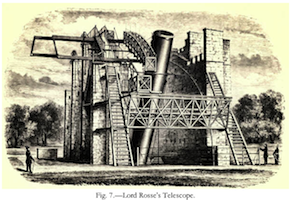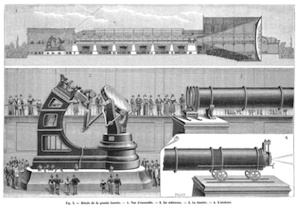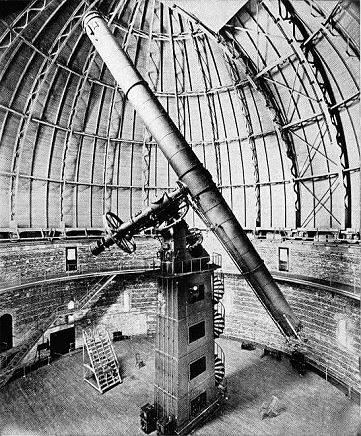The use of astronomical telescopes initiated by Galileo and Kepler at the beginning of the seventeenth century initiated the development of ever-larger observational instruments for the study of faint stars and the detection of finer details. Since then, the race for high angular resolution has never ceased.
Having about one inch (2.5cm) in diameter in 1609, the lenses reached ten inches (25cm) around 1820 and 40 inches (1m) around 1900.
Simultaneously, speculum mirrors of reflecting telescopes went from 6 inches (15 cm) in the early eighteenth century to 72 inches (1.80 m) in the middle of the nineteenth century.
 |
|
| "Commissioned in 1845, this telescope had a mirror with a diameter of 1.83 m. It was placed in a 17 m long tube which was suspended between two north-south 15m-high stone walls. Called "Leviathan", the instrument built in Parsonstown (Birr, Ireland), by Lord Rosse, was the largest reflecting telescope in the world. From the 1860s onwards, the construction of telescopes with metallic mirrors was gradually abandoned and replaced by telescopes with mirrors made of glass which were more reflective. The first glass mirror surpassing in size the Leviathan was the telescope of 100 inches (2.54 m) commissioned for Mount Wilson in 1917"1. | "The world’s largest telescope ever to be built was shown to the public in 1893 at the Universal Exhibition in Chicago, before being installed at the Yerkes Observatory in 1897. The objective lens had a diameter of 102 cm. The glass was cast in France by Edouard Mantes, and ground by the famous American opticians Alvan Clark & Sons at Cambridgeport (Mass.). The telescope mount was built by the "Warner & Swasey" company of Cleveland (Ohio)."2. |
In 1862, Foucault, to whom we owe the invention of telescopes using glass mirrors – that are much more reflective than speculum mirrors - built a telescope with an 80cm mirror that was installed in 1864 at Marseille’s Observatory. With this revolutionary telescope, a new race to high resolution began, having as a result giant mirrors that reached 5m in diameter in the middle of the twentieth century and more than 10m in 2005.
Meanwhile, the race for very large glasses had ceased. On the occasion of the Universal Exhibition in Paris in 1900, the French manufacturer Paul Gautier had built at his own expense a refracting telescope a lot more powerful than "the largest telescope in the world" commissioned three years earlier at the Yerkes Observatory (Wis., USA). With its 60m-long tube and its objective lens of 1.25m in diameter, it attracted the crowds of the Exhibition, but found no buyer. This unfortunate experience that led Gautier to bankruptcy announced the end of giant lenses.

The prize piece of the Paris Exhibition in 1900 was the enormous telescope shown at the « Palais de l’Optique».
Its objective lens had a diameter of 1.25 m and a focal length of 57 m. Since it could not be installed under a dome,
it was mounted horizontally on pillars made of masonry, oriented in a north-south direction.
Light from stars was caught by a Foucault siderostat equipped with a giant 2m-diameter movable plane mirror.3
In 1868, Fizeau had, for the first time, the idea of using interferometry to increase the resolution of a telescope: two small mirrors placed at a distance on the surface of a large virtual mirror produces the same resolution as the large mirror itself. In 1873, Fizeau’s colleague, Stephan, tested this method with the 80cm telescope of the Marseille observatory. In 1890, on returning from a trip to Paris to visit Fizeau’s laboratory, the American physicist Michelson measured the diameter of Jupiter’s four satellites using interferometry. Later, Michelson and his assistant Pease conceived an interferometer that they installed on the 100-inch telescope at the Mount-Wilson observatory. In 1920 they were able to measure for the first time the diameter of a star.
Revisiting in the 1970’s the work done by Michelson, Antoine Labeyrie had the idea of replacing the installation of an interferometer on a large telescope by several telescopes phased using interferometry. In 1974, while at the observatory of Nice (Mont-Gros 375m), he succeeded in making the light of a star captured by two small telescopes to interfere. This led the way to his “interferometer with two telescopes” (I2T) and then to the current large interferometers of Hawaii and Chile.
Image Credits
1. Robert Stawell Ball "The Story of the Heavens". Cassell and company, Limited. London, 1900, p.18.
2. Yerkes Observatory, wikipedia.
3. Léon Barré "La Nature", 1899, I, p. 169.



